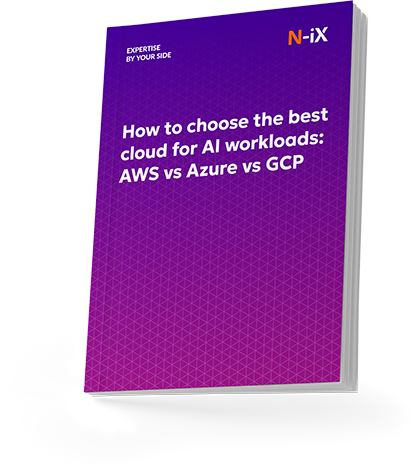Machine Learning in cloud computing has already fundamentally changed how businesses operate and strategize. According to PWC’s 2024 Cloud and AI Business Survey, 92% of companies that are already capitalizing on their ML investments plan to increase their cloud budgets. The reason? Most responders unanimously agree that cloud solutions support their ability to maintain and expand ML initiatives.

Cloud platforms provide the essential infrastructure that ML workloads demand, including scalable resources and powerful computing capabilities. Machine Learning, in turn, enables competitive data analysis, intelligent decision-making, and robust automation across industries.
With cloud computing and Machine Learning fueling faster innovation and enhanced service, the main challenge is combining them effectively. In this guide, N-iX experts define the most important factors to get right when implementing ML in the cloud. Read on to discover practical tips and real-world use cases where these technologies deliver measurable results.
Key considerations for Machine Learning in cloud computing projects
Using cloud computing for Machine Learning requires strategic planning in several critical areas. Make sure to consider the following aspects before launching your ML initiatives in the cloud:
Managed ML platforms vs custom pipelines
When building ML solutions in the cloud, enterprises often choose between managed ML platforms and custom-built pipelines. Managed platforms, such as AWS SageMaker and Google Vertex AI, offer integrated tools for the entire Machine Learning project lifecycle. These services provide pre-built environments, auto-scaling infrastructure, experiment tracking, and orchestration. If you’re looking to accelerate time-to-value and reduce operational overhead, managed platforms can be right for your needs.
In contrast, custom ML pipelines are typically built using a combination of open-source tools (like MLflow, Airflow, or Kubeflow) and cloud-native services. They can be tailored to specific requirements that managed platforms may not fully support. Custom ML pipelines also give organizations more flexibility and control.
When it comes to choosing the best approach, our experts recommend evaluating your organization’s needs and existing infrastructure.
In our experience implementing both approaches, the decision between managed and custom services often evolves over time. Organizations frequently start with managed services to build momentum, then selectively customize components as their ML capabilities mature. The cloud gives you the flexibility to adopt this hybrid approach without committing to either extreme.
Cost control strategies for long-running ML jobs
Cost management is crucial for ML projects in the cloud, especially when dealing with extended training jobs. Here are several effective strategies you can implement to optimize your spending:
- Using Spot Instances for interruptible training jobs (up to 90% savings, according to AWS);
- Implementing auto-scaling for model endpoints to optimize resource usage;
- Configuring automatic shutdown for idle compute instances;
- Monitoring performance metrics to identify and eliminate waste.
Discover more cloud cost optimization strategies and tips
Multi-cloud vs single-cloud vs hybrid cloud for ML workloads
Single-cloud environments offer simplicity and straightforward management, with all resources centralized on one platform. They typically enable deeper integration among services since all applications operate within the same ecosystem.
AWS, Azure, or GCP? Choose the best cloud for AI workloads!


Success!

At the same time, multi-cloud strategies distribute workloads across different providers, offering enhanced risk mitigation, resilience, and access to specialized ML tools. This approach is often used to avoid vendor lock-in or meet specific workload needs with the most suitable cloud services.
Another option, the hybrid cloud, combines public and private environments. Hybrid infrastructures are commonly used when organizations need to meet strict regulatory requirements or keep sensitive data on-premises while running ML models in the cloud.
So, how to determine which one is right for your business needs? If you comply with industry-specific security requirements or prioritize preventing vendor lock-in, multi-cloud and hybrid cloud strategies can be a good fit. At the same time, a single-cloud setup can also be a practical choice. It offers the fastest and most straightforward path forward, which is particularly useful for early-stage ML initiatives.
Security and compliance for ML data
Choosing the right cloud model is only one part of securing Machine Learning workloads. To meet growing regulatory demands and protect sensitive assets, organizations must secure both their infrastructure and data throughout the ML lifecycle.
When N-iX teams build environments for Machine Learning in cloud computing projects, our cloud security experts typically implement the following measures:
- Isolating critical ML components within private cloud networks;
- Encrypting data in transit and at rest;
- Applying strict identity and access management strategies based on least privilege;
- Enabling audit logging and monitoring for key activities;
- Managing secrets and credentials securely using vault services.
Real-world applications of Machine Learning in the cloud
Machine Learning and cloud computing deliver tangible business outcomes when applied to real-world challenges. But what exactly are they capable of? Let’s explore three projects where N-iX combined these technologies to solve specific issues across fintech, telecom, and ecommerce.
Case #1: Fraud detection and automated transaction handling in fintech
Machine Learning in cloud computing enables real-time fraud detection by processing millions of transactions instantly and identifying patterns invisible to human analysts. It also helps financial institutions automatically approve or decline payments, routing only high-risk cases for manual review.
Our client, a large financial services provider based in the UK, partnered with N-iX to streamline transaction processing and compliance with Anti-Money Laundering (AML) and anti-fraud regulations. The company wanted to centralize decision-making while enabling instant payment, even for peak transaction volumes.
Our team built a cloud-agnostic ML solution that automatically evaluates each payment based on customer history, login behavior, IP address, and credit information. Key project goals included:
- Building a Machine Learning Operations (MLOps) pipeline to streamline model deployment;
- Establishing real-time data processing to enable ML-powered decisions;
- Creating a single system to manage and test decision-making logic;
- Consolidating the client’s previously developed ML models into a single solution.
After the launch, the client was able to decrease transaction processing latency to 250 milliseconds from up to 5 minutes. Furthermore, they saw a 20% increase in the number of customers and a 35-point rise in their Net Promoter Score (NPS), indicating a high level of customer satisfaction.

Explore the full case: Preventing fraud and automating payment processing with ML
Case #2: Predictive equipment maintenance in telecom
Unnecessary downtime is a financial sinkhole for businesses. For instance, our client, a global in-flight Internet provider, struggled with unexpected equipment failure. Their satellite antennas sometimes malfunctioned without a clear cause, affecting service quality and triggering costly penalties from airlines.
To address the issue, the N-iX team helped the client migrate to AWS and developed a unified cloud-based data platform. This allowed us to implement Machine Learning in the cloud and establish real-time monitoring of antenna health, leading to advanced failure prediction. Here’s what we implemented:
- Cloud migration to enable the processing of up to 3 TB of daily streaming data from over 20 sources;
- A unified data platform to aggregate telemetry such as uptime and concurrent in-flight Wi-Fi sessions;
- Predictive analytics models, including the Gaussian Mixture Model and Regression Analysis for failure forecasting;
- A data pipeline correlating degraded antenna performance with weather conditions and equipment architecture;
- A user experience monitoring tool to detect pain points in the first 15 seconds of connection attempts.
These capabilities enabled the client to identify the main cause of antenna degradation and prevent future failures. As a result, the client significantly reduced service disruptions and saved costs previously spent on their on-premises infrastructure.

Read the full case: Enhancing maintenance and operation of in-flight Internet
Case #3: Churn prediction in ecommerce
Cloud-based Machine Learning enables businesses to deliver personalized experiences, predict customer behavior, and automate responses. These capabilities are especially crucial in subscription-based ecommerce, where tailored engagement directly impacts customer retention.
Our client, a global provider of ecommerce and subscription management platforms, wanted to expand their email marketing feature with churn prediction and automated campaign targeting. Their goal was to segment users, predict cancellations, and reduce the manual workload involved in managing campaigns.
To meet these needs, N-iX delivered a cloud-native ML-powered solution integrated into the client’s platform. Our team’s key steps included:
- Developing a proof of concept (PoC) prototype and designing the architecture to automate marketing workflows;
- Building a serverless AWS-based solution to cut infrastructure costs and enable seamless ML integration;
- Applying MLOps best practices to streamline the deployment and monitoring of campaign automation models;
- Enabling multi-tenant ML capabilities using Amazon SageMaker to predict churn and email engagement rates.
By successfully implementing Machine Learning in cloud computing, we helped the client automate targeted marketing based on user behavior, ultimately boosting their customer retention and acquisition.

Find the full case here: Predicting cancellations in ecommerce with Machine Learning
Wrapping up
Machine Learning in cloud computing has reshaped how organizations approach data processing decision-making. The real-world applications we’ve examined demonstrate tangible business impact across industries. Financial institutions combat fraud more effectively, telecom enterprises prevent costly downtime, and ecommerce vendors improve customer experience.
However, implementing cloud-based Machine Learning comes with its challenges. Organizations need thoughtful planning, appropriate platform selection, and expert guidance to navigate the evolving landscape effectively. The question is no longer whether to use the cloud for ML but how to optimize your strategy for maximum business impact.
Why should you partner with N-iX for your cloud Machine Learning project?
Selecting the right partner for ML and cloud integration can determine the success of your digital initiatives. With 23 years of proven experience in cloud development across manufacturing, logistics, fintech, and telecom industries, N-iX brings the expertise organizations need to succeed.
- Our specialized data and ML team of 200 professionals offers deep expertise in building AI strategies, implementing ML models, and deploying Machine Learning pipelines.
- The N-iX team includes more than 400 cloud experts who have completed over 150 cloud projects in the last five years, delivering reliable cloud-based AI and ML integration tailored to specific business requirements.
- N-iX has earned distinction as one of the first companies worldwide to become a Solutions Partner in the Microsoft AI Cloud Partner Program.
- We have obtained Visual Intelligence Expertise as part of Google Cloud’s Partner Advantage program and achieved Premier Tier Services Status in the AWS Partner Network.
- Certified in ISO 27001, ISO 9001:2015, SOC 2, and PCI DSS, N-iX ensures your data remains secure throughout the entire ML implementation process.
Have a question?
Speak to an expert




